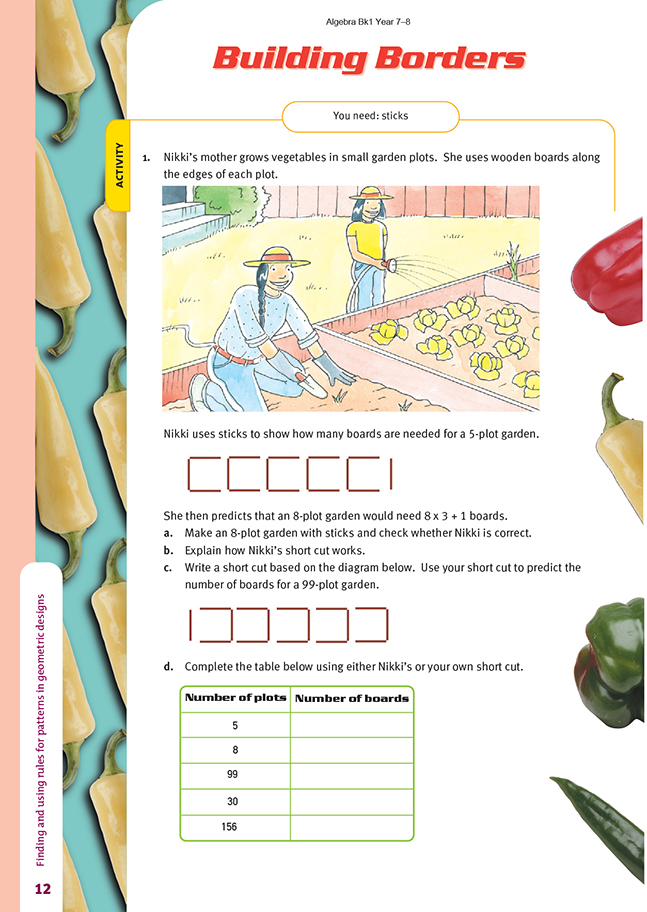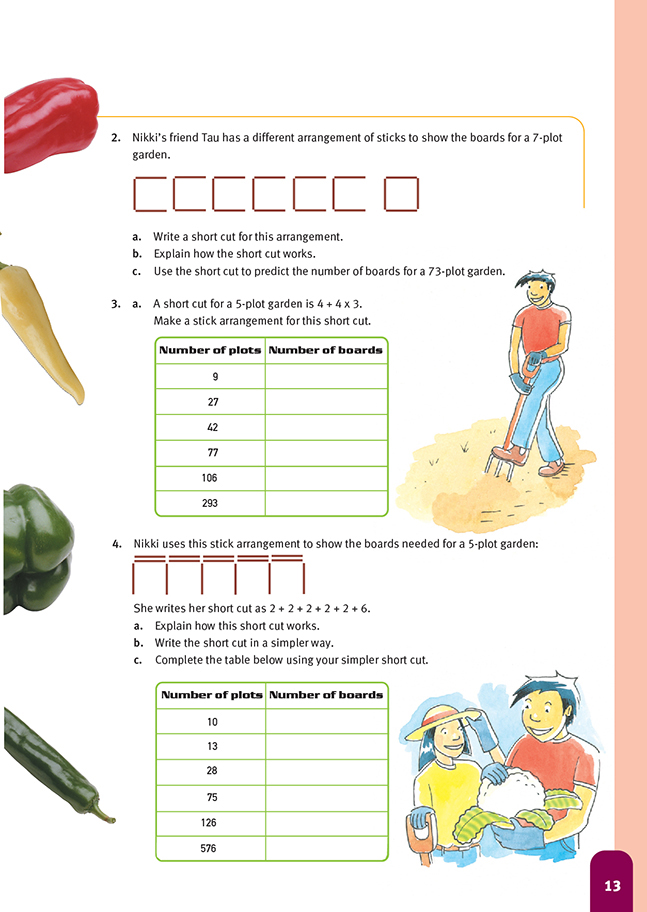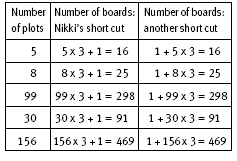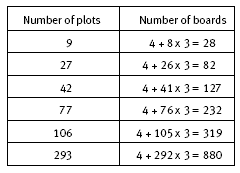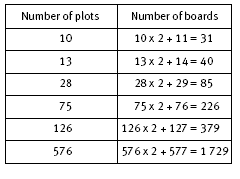This is a level 4 algebra strand link activity from the Figure It Out series.
A PDF of the student activity is included.
Click on the image to enlarge it. Click again to close. Download PDF (271 KB)
use a table to find a rule for a geometric pattern
write a rule to describe a relationship
FIO, Link, Algebra, Book One, Building Borders, pages 12-13
sticks
This activity is very similar to that on page 6 of the students’ book and again requires students to break down a pattern in order to get to grips with its behaviour mathematically.
In question 1a, the students build an 8-plot garden by extending the arrangement they are given for a 5-plot garden. The arrangement they make helps them visualise the garden as 8 sets of 3 boards and 1 extra board.
In question 1b, the students are asked to explain how the geometrical structure of the arrangement of the boards matches the numerical expression 8 x 3 + 1. This expression is a short cut because it provides a quick way to count the number of boards in an 8-plot garden. The following diagrams show how similar short cuts
work for a 2-plot garden and then a 5-plot garden. The students may need to use sticks to build “gardens” with different numbers of plots so that they can see clearly how the short cuts work.
In question 1c, the diagram for a 5-plot garden has been reversed. So, instead of visualising 5 x 3 + 1 boards, we now see 1 + 5 x 3 boards. Although they are based on different ways of visualising the boards, the two short cuts have the same numerical value, in this case, 16. In fact, rotating the diagram in question 1c through
180 degrees, by turning the page upside down, will give the diagram Nikki used, so the two short cuts are clearly equivalent. Once the students visualise a 5-plot garden as having 1 + 5 x 3 boards, they may reason that a 99-plot garden has 1 + 99 x 3 boards. Such reasoning involves the rule:
the number of boards = 1 + number of plots x 3. The rule based on the short cut 5 x 3 + 1 for a 5-plot garden is: the number of boards = number of plots x 3 + 1.
Note that the rules are expressed here in words rather than in symbols because the students are not expected to use the symbolic language of algebra at this stage. If they were to use it and there were x plots, then the number of boards, y, can be expressed by the rules y = 3 x x + 1 or y = 1 + 3 x x. However, 3 x x is usually
written more simply as 3 x, so the rules are y = 3 x + 1 or y = 1 + 3 x.
Note that the short cuts used in this activity will only work for plots in a row. Other arrangements may use fewer boards. For example, the students may discover that the arrangement of 4 plots in a 2 by 2 grid uses only 12 boards, whereas 13 boards are needed for 4 plots in a row.
In the 2 by 2 grid, the fourth plot requires only 2 boards to complete it. In general, rectangular arrangements of plots will require fewer boards than plots arranged in single rows.
In question 2, the arrangement helps us visualise the 7-plot garden as having the first 6 of the 7 plots with 3 boards each and the last plot with 4 boards. So, altogether, we see 6 x 3 + 4 boards. Therefore, a garden with 5 plots has 4 x 3 + 4 = 16 boards, and a garden with 73 plots has 72 x 3 + 4 = 220 boards.
An arrangement that helps us visualise a 5-plot garden as having 4 x 3 + 4 boards is:
So, in question 3, an arrangement that helps us visualise a 5-plot garden as having 4 + 4 x 3 boards is:
We can express Tau’s rule in words as “The number of boards = (number of plots – 1) x 3 + 4.” Using x for the number of plots and y for the number of boards, the rule is y = ( x – 1) x 3 + 4, or y = 3( x– 1) + 4. The algebraic rule for the reversed arrangement is y = 4 + 3( x – 1). Finally, in question 4, another arrangement is given to help the students visualise the boards needed for a 5-plot garden. There are 5 sets of 2 boards (shown horizontally) and 6 vertical boards. So, for a 10-plot garden,
we can reason that there are 10 sets of 2 horizontal boards and 11 vertical boards. So the rule is: the number of boards = (number of plots x 2) + (number of plots + 1). Using x for the number of plots and y for the number x of boards, the algebraic rule is y = x x 2 + x + 1, or y = 2 x + x + 1.
If the students are finding question 4c difficult, it may help to introduce a further two columns to the table to help make the pattern and calculations clearer:
Note that we have expressed rules for the number of boards in a garden with any number of plots in several different ways:
y = 3 x + 1
y = 1 + 3 x
y = 3( x – 1) + 4, which simplifies to y = 3 x – 3 + 4 or y = 3 x + 1
y = 4 + 3( x – 1), which simplifies to y = 4 + 3 x – 3 or y = 1 + 3 x
y = 2 x + x + 1, which simplifies to y = 3 x + 1.
The rules all simplify to either y = 3 x + 1 or y = 1 + 3 x, which shows that all the short cuts we have considered share the same underlying mathematical structure.
Answers to Activity
1. a. Nikki is correct. An 8-plot garden has 8 x 3 + 1 = 25 boards.
b. Each plot has 4 boards on its edge. One of the boards is also on the edge of the adjacent plot (the one next to it). An additional board is needed at the end of a row of plots to complete the border for the last plot. So, a garden with 2 plots has 2 x 3 + 1 boards, a garden with 5 plots has 5 x 3 + 1 boards, and so on.
c. 1 + 5 x 3. So a 99-plot garden will have 1 + 99 x 3 = 298 boards.
d. The second short cut in the table below is based on the diagram in 1c.
2. a. The short cut for the 7-plot garden is 6 x 3 + 4.
b. For a 7-plot garden, 6 plots have 3 boards each (a total of 6 x 3 boards) and the last plot needs 4 boards. So 6 x 3 + 4 = 22 boards are needed altogether.
c. 220 boards (72 x 3 + 4)
3. a. The most likely arrangement is:
(There are other possibilities, but they do not fit in with the horizontal pattern that you have been working with earlier.)
b.
4. a. For a 5-plot garden, 6 boards in the diagram are vertical. There are 2 boards in each of the 5 spaces between the 6 vertical boards. So there are 5 sets of 2 boards or 2 + 2 + 2 + 2 + 2 boards in the 5 spaces. Altogether, there are 2 + 2 + 2 + 2 + 2 + 6 boards.
b. 2 + 2 + 2 + 2 + 2 boards is the same as 5 x 2 boards. So a simpler short cut is 5 x 2 + 6.
c.
